Cardcaptor Sakura: Collector’s Edition Review
NOTE: Much of what is written here can also be found in the Cardcaptor Sakura chapter of Ian’s forthcoming book CLAMPdown, detailing the history of series creators CLAMP. To find out more, including details of when the book will be released, you can follow the book’s Twitter account @clampdownbook
After four delays since All The Anime originally intended to release it, the Blu-ray collector’s edition of the anime adaptation of one of the most famous magical girl stories is finally with us.
Cardcaptor Sakura is the best known and most loved of all of CLAMP’s works. Perhaps the biggest indicator of this from a British perspective is that the anime version of it is one of the few anime series to be shown on a mainstream TV channel. The anime aired on CITV, back in the days when it was a segment on the main ITV channel. It has also been streamed on All4, Funimation, Crunchyroll and although not confirmed yet it may well be part of All The Anime’s deal with forthcoming streaming service ITVX.
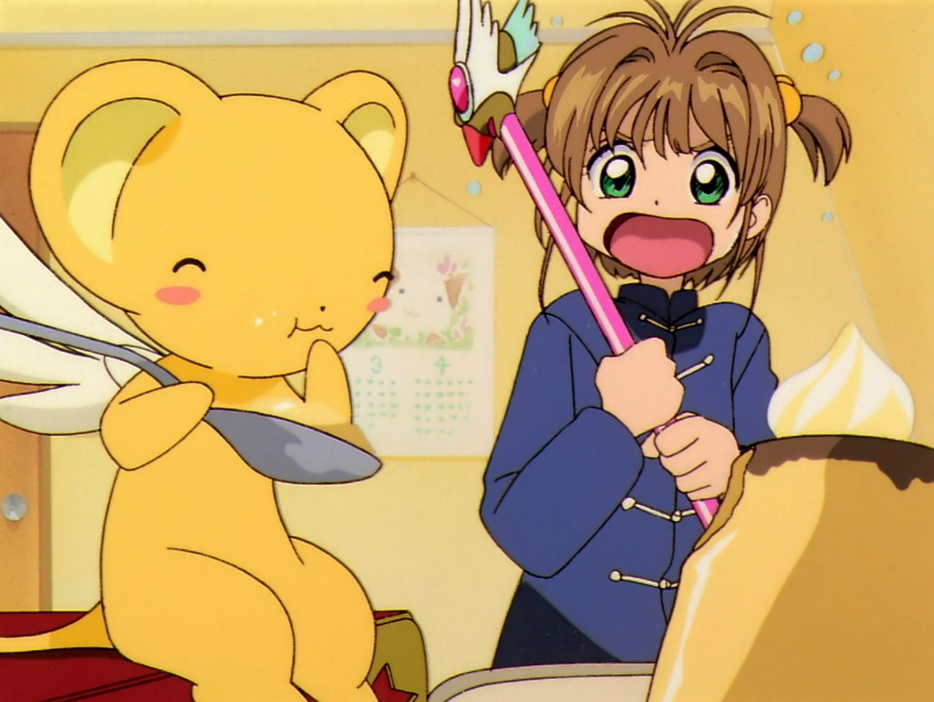
However, when I say that it aired on CITV, that is not the entire truth. It is more accurate to say that a particular version of Cardcaptor Sakura was broadcast. This was called Cardcaptors, and this translation by the Canadian company Nelvana is one of the most notorious reworks of any anime known. Not only was the title changed, but so were the names of the characters and locations to make them more English-sounding, and elements of the story considered unsuitable to children, such as gay romance, were removed, despite children being the target audience for the series back in Japan. Jake L. Godek from the website T.H.E.M. Anime described Cardcaptors as: “The worst thing that has ever happened to anime that had a good Japanese name.” It was one of the worst rebrandings ever.
Fortunately for us, this is not the version we have been given. All The Anime’s version comes with a later dub which covered the entire show (with the exception of one episode trailer and a post-credits scene following the final episode of the series), as well as remastered animation in 4K resolution.
The story follows 4th grade elementary school student Sakura Kinomoto, who lives in the fictional city of Tomoeda with her archaeology professor father Fujitaka, and her older brother Toya, with whom she regularly gets into rows. Her mother, Nadeshiko, died when Sakura was only three, at the age of 27.
Sakura goes to school – via rollerblading (it was the nineties) – and is always happy to meet up with Toya’s classmate Yukito “Yuki” Tsukishiro, as she loves him, although she is unaware that Yukito is actually in love with her brother. In her class Sakura has several friends: there are two fellow members of her cheerleading club, Naoko Yangisawa, whose passion for ghost stories scares Sakura, and Chiharu Mihara, who is in a relationship with fellow student Takashi Yamazaki, a boy who is constantly telling tall tales which Sakura frequently falls for. There is also Rika Sasaki, who Sakura knows is in love with someone but she doesn’t know who. Disturbingly, we the viewers find out it is actually the class’s homeroom teacher Mr. Terada – although the original manga took this even further by saying the two were engaged. Thankfully this got toned down when the anime adapted the story.

However, Sakura’s best friend, and also second cousin, is Tomoyo Daidouji, whose mother Sonomi runs a toy company and was also Nadeshiko’s cousin. Indeed, Sonomi has never forgiven Fujitaka for taking Nadeshiko away from her. Tomoyo has many passions in live, but her main one is dressing up Sakura in all kinds of outfits she makes herself and filming her on camera. As Sakura herself says: “She’s a good friend, but just a little… weird.”
While in her father’s study, Sakura bumps into and opens a book which contains lots of cards. These cards turn out to be magical, and by opening the book Sakura has let them loose around the town. Opening the book also releases the guardian of the cards, a magical being called Cerberus (or Kerberos in the English dub), who despite being named after a three-headed dog, actually takes the form of a cuddly toy, looking a bit like a winged lion cub. Cerberus, or, as Sakura decides to call him, Kero, tells her that the cards were created by a long-dead Anglo-Chinese sorcerer named Clow Reed. With the cards loose in the world, they do as they please and therefore need to be captured and returned to the book. By opening the book in the first place, this demonstrates that Sakura has some form of magic power within her, and thus Kero makes Sakura the ‘Cardcaptor’. He gives her the key to the book, which Sakura can transform into a magic staff that she can use to get the cards back. Every time Sakura captures a card, she writes her name upon it to make the card hers, and then she can use its magical properties. The Clow Cards themselves include: The Fly, The Jump, The Windy and The Sword.
Together, Sakura and Kero try to capture all the cards, although for much of the time Kero has to pretend to be a cuddly toy to avoid arousing the suspicion of others, especially Toya, although we the viewers come to learn he has some magical powers of his own. The only other person who knows about the cards is Tomoyo, with her effectively becoming a Lois Lane to Sakura’s Superman, albeit one who is ecstatic that she can film her ‘love’ in even more outfits.
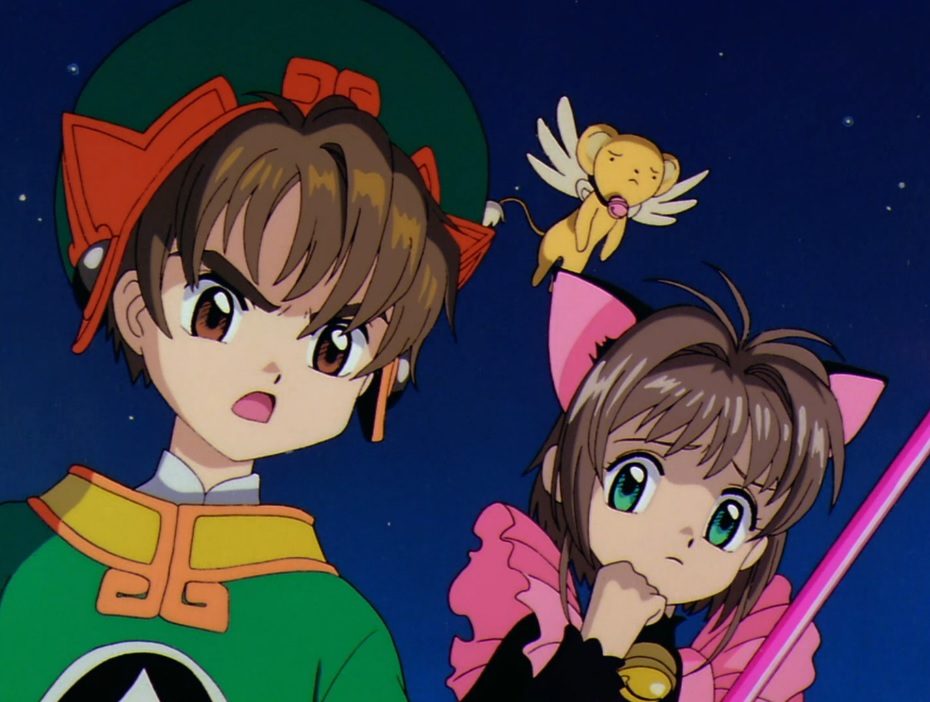
Things become even more complicated however with new arrivals to the school. The first is an exchange student from Hong Kong named Syaoran Li (Li Showron in the dub), a descendent of Clow Reed who first tries to capture the Clow Cards himself, but as the series progresses he and Sakura begin to work together and even fall in love. They are also later joined by Syaoran’s cousin Meiling (sometimes spelled Meilin), a character totally original to the anime who has no magical powers herself but is a skilled fighter, and claims she is engaged to Syaoran. Other people who also have connections to Clow Reed also appear, such as substitute teacher and local shrine maiden Kaho Mizuki, and English exchange student Eriol Hiiragizawa.
Regardless of all this, Sakura knows that she has to capture all the cards because if she doesn’t, disaster will befall the entire world.
There is a fair amount to discuss when it comes to Cardcaptor Sakura: some positive, some negative, and some relating to ideas that I have that make the story a bit weird.
In terms of good points, the best is the artwork, enhanced by this new 4K restoration. The character design especially is wonderful. When it comes to magical girl series like this, comparisons to Sailor Moon are inevitable, and rightly so when you consider that both manga ran in the same magazine. However, while Sailor Moon only has one classic outfit when she transforms, Sakura has an entire wardrobe thanks to Tomoyo. If there is ever a character that helps to encapsulate the concept of “kawaii”, then Sakura has to be one of the top candidates.

Another interesting aspect to bring up is the dub. While the Cardcaptors version is one of the most infamous, the one used in this collection developed by Animax is much more listenable, and I have no objection to Andrea Kwan’s performance as Sakura, but the man voicing Yamazaki (I can’t find the name, and the collection doesn’t list any English credits) sounds too old, given that all the kids in Sakura’s class are pre-teens. There are some other issues with the dub that are worth mentioning: scenes in which Tomoyo sings are not translated, and one scene in which the class are all playing the recorder for a music lesson is mistranslated, so they constantly talk about playing the flute, even though the subtitled version gives the right instrument.
The subtitles used in this collect are an improvement on previous ones I’ve seen used for the show: for example, I’ve seen US releases which have needlessly changed 170 degrees Celsius into 338 degrees Fahrenheit. However, there are still some peculiar moments, perhaps best illustrated by the most famous meme the series ever produced: a very happy Sakura with the subtitle: “At this rate, everything will burn!” Turns out that Sakura is actually saying this in voice-over, as this moment is actually from a still from a trailer – for the Christmas episode.
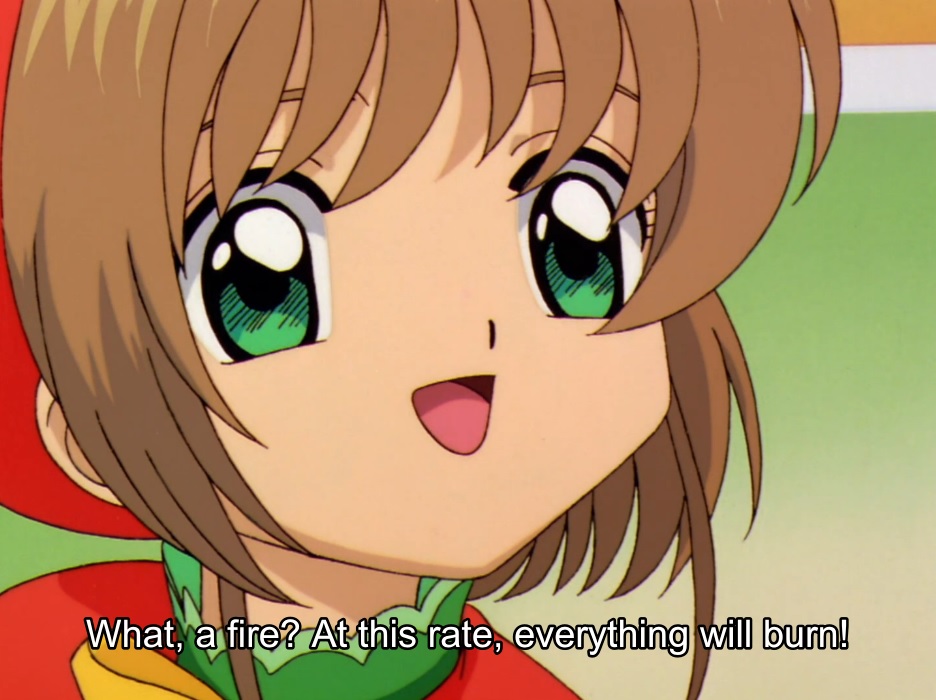
In terms of negatives, well there is not that much bonus material in this collection. You do get a nice case to store your collection in, as well as a booklet containing artwork from the series and an extensive article by Andrew Osmond about the history of the show. Other than this however, the only extras on the disc are textless opening and closing. However, this does lead to another highlight of the show: the music, with the best track as far as I’m concerned being the opening music for when the series debuted: “Catch You Catch Me” by Gumi. When it comes to missing content, it would have been good if this collection also included the two feature films that were made of the series.
Some aspects of Cardcaptor Sakura are a lot more mixed, and this mainly comes in the form of the relationships between the characters. Some like that between Sakura and Syaoran are obviously great; others, such as the gay love between Toya and Yukito are clearly visible but only hinted at in the dialogue. Other relationships are much more problematic, especially Rika and Mr. Terada which, as mentioned, got toned down when the series was adapted, and is virtually shunted out when the sequel Cardcaptor Sakura: Clear Card was made by having Rika go to a different school from the others. Also, there are two cases of intimate relationships between cousins, with Sakura and Tomoyo, and Syaoran and Meiling. When Fujitaka and Nadeshiko first met, he was 25, and she was just 16. This wasn’t the first time CLAMP have had this age gap relationship, as these were also the ages of gay lovers Seishiro and Subaru when they first met in Tokyo Babylon.
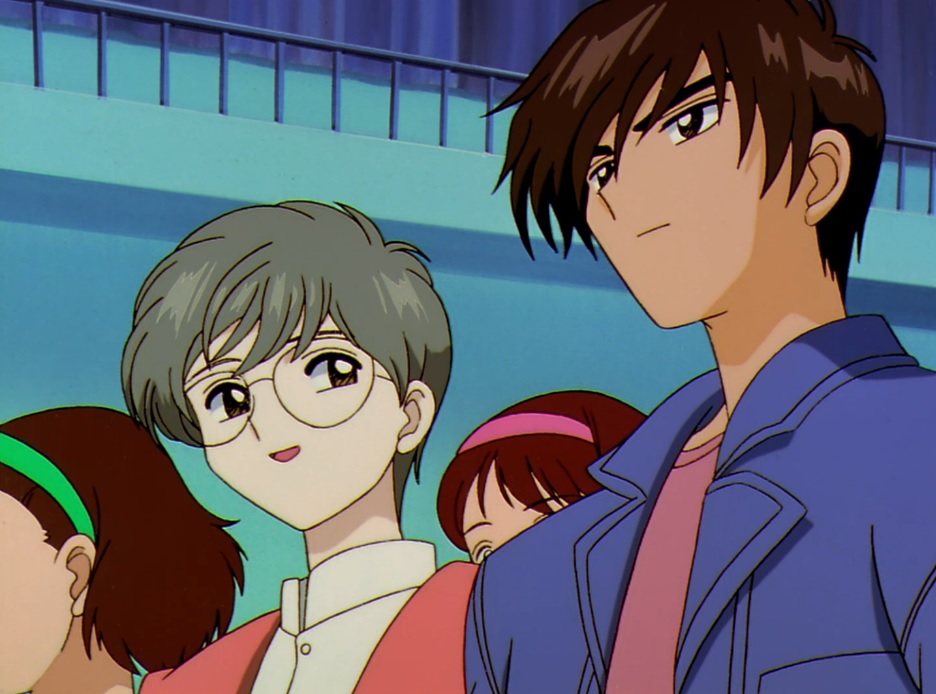
However, and this is where I deviate from several other people, I think Sakura and Tomoyo’s relationship is much more sinister than most viewers believe. In the eighth episode (the one which introduces Syaoran), Sakura has to capture the Thunder card. In the original manga, this section is just a few pages long, but in the anime it is an entire episode. In both cases, Sakura does this while wearing one of Tomoyo’s outfits: a catgirl/maid costume. In the anime however, the Thunder card is so dangerous that when the outfit debuts, Tomoyo tells Sakura that she has made it entirely out of rubber to protect her. When asked about why the outfit has cat ears, Tomoyo says she put them on because they look cute. Now, I think this is all wrong. I think that a 10-year-old girl dressing as a catgirl wearing rubber is not exactly a suitable thing. Parts of it are, but all together it’s wrong. Permit me to illustrate this with the following Venn diagram.
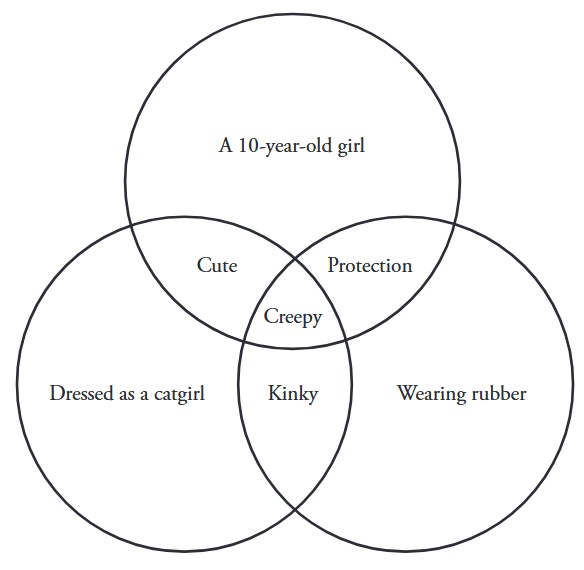
Put it this way, if you were out in the street and you came across a 10-year-old girl dressed as a catgirl wearing rubber, I suspect that there might be a phone call to social services. I said earlier that Tomoyo is like Lois Lane, but I think she is more like the 13th Duke of Wybourne from The Fast Show, who would be happy to say things like: “Me? Tomoyo Daidouji, here, in Tomoeda’s Penguin Park, dressing a 10-year-old girl in a rubber catgirl costume, while armed with a camcorder, at three o’clock in the morning, with my reputation? Poor little thing’s never even heard of upskirting!” This girl must be stopped!
What actually happened was that in 2016, we got the sequel, Cardcaptor Sakura: Clear Card, which had its own weirdness. Namely, given that in the story the characters had only aged by about two years, how come they are all now using 21st century technology like smartphones and drones?
While I admit that Cardcaptor Sakura is not my favourite of CLAMP’s work (see here for which ones are), it is nevertheless a fan favourite. It is still a joy to watch this show which for many was an early exposure to anime, even if that original version was somewhat bastardised. Also, it is PG-rated, so it is a nice way to introduce youngsters to anime too. As for Cardcaptor Sakura itself, well Clear Card is approaching its conclusion and next year we will see xxxHOLiC: Rei returning. Let’s hope other stories also return one day – I’m looking at you X!


